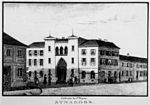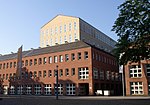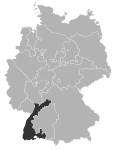Karlsruhe

Karlsruhe ( KARLZ-roo-ə, US also KARLSS-, German: [ˈkaʁlsˌʁuːə] (listen); South Franconian: Kallsruh) is the third-largest city of the German state (Land) of Baden-Württemberg after its capital of Stuttgart, and Mannheim, and the 21st-largest city in the nation, with 308,436 inhabitants. It is also a former capital of Baden, a historic region named after Hohenbaden Castle in the city of Baden-Baden. Located on the right bank of the Rhine near the French border, between the Mannheim/Ludwigshafen conurbation to the north and Strasbourg/Kehl to the south, Karlsruhe is Germany's legal center, being home to the Federal Constitutional Court (Bundesverfassungsgericht), the Federal Court of Justice (Bundesgerichtshof) and the Public Prosecutor General of the Federal Court of Justice (Generalbundesanwalt beim Bundesgerichtshof). Karlsruhe was the capital of the Margraviate of Baden-Durlach (Durlach: 1565–1718; Karlsruhe: 1718–1771), the Margraviate of Baden (1771–1803), the Electorate of Baden (1803–1806), the Grand Duchy of Baden (1806–1918), and the Republic of Baden (1918–1945). Its most remarkable building is Karlsruhe Palace, which was built in 1715. There are nine institutions of higher education in the city, most notably the Karlsruhe Institute of Technology (Karlsruher Institut für Technologie). Karlsruhe/Baden-Baden Airport (Flughafen Karlsruhe/Baden-Baden) is the second-busiest airport of Baden-Württemberg after Stuttgart Airport, and the 17th-busiest airport of Germany.
Excerpt from the Wikipedia article Karlsruhe (License: CC BY-SA 3.0, Authors, Images).Karlsruhe
Karl-Friedrich-Straße, Karlsruhe Innenstadt-Ost
Geographical coordinates (GPS) Address Website Nearby Places Show on map
Geographical coordinates (GPS)
| Latitude | Longitude |
|---|---|
| N 49.0092097 ° | E 8.4039514 ° |
Address
Pyramide
Karl-Friedrich-Straße
76133 Karlsruhe, Innenstadt-Ost
Baden-Württemberg, Germany
Open on Google Maps











